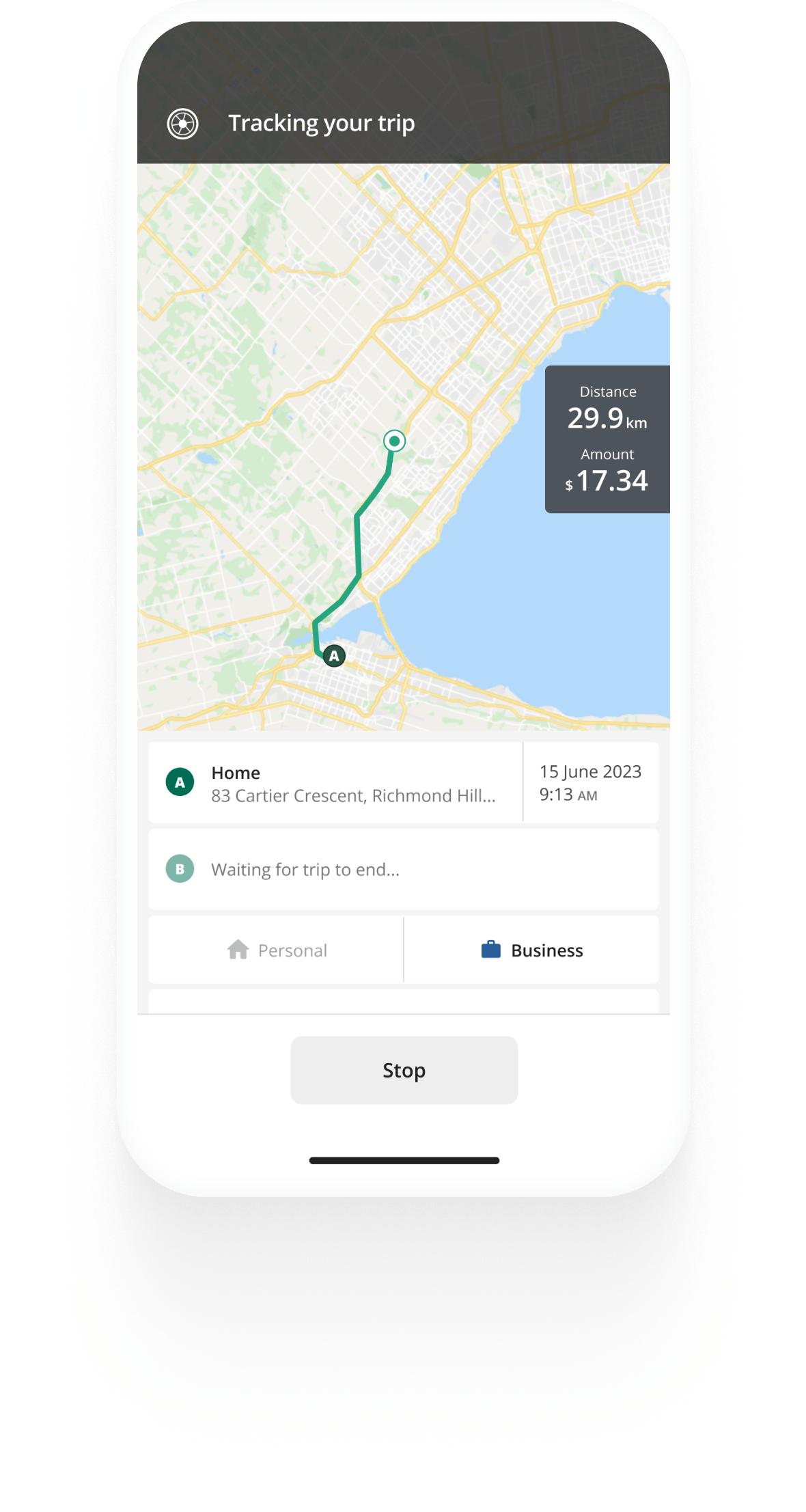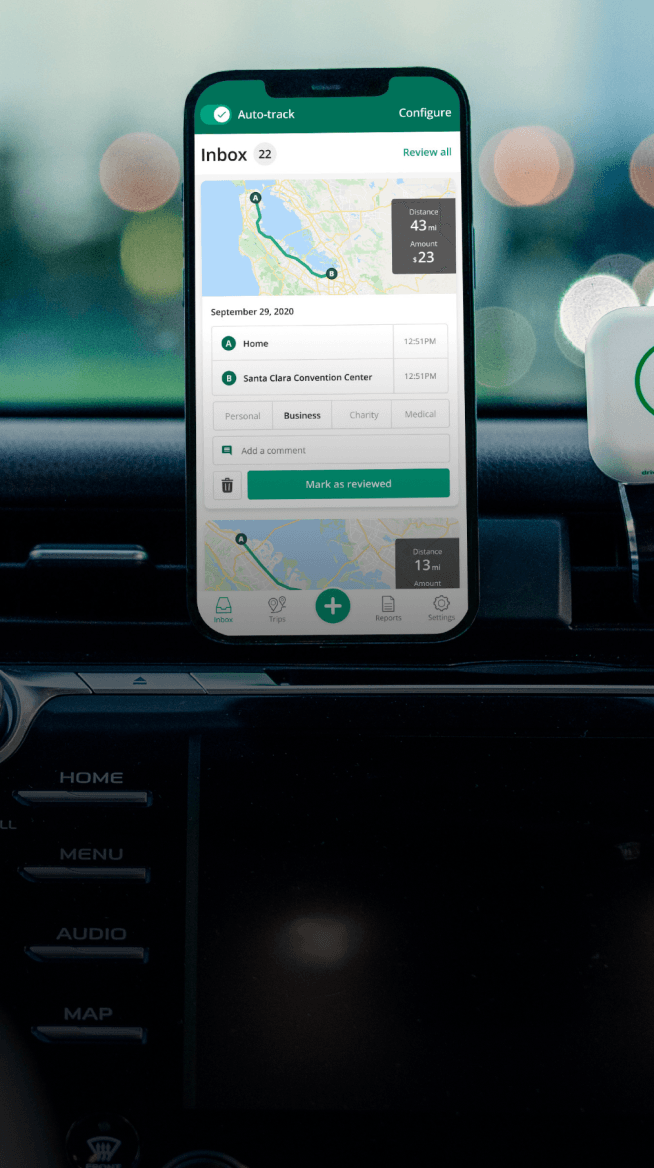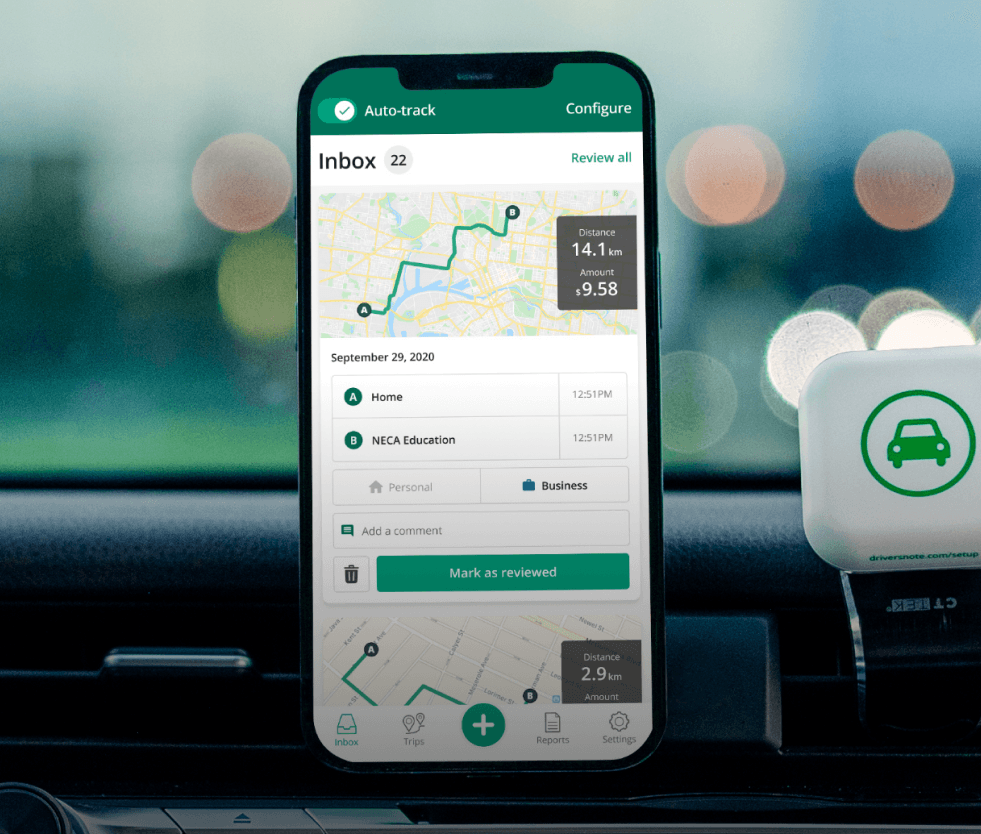Track mileage automatically
Get startedCRA Mileage Reimbursement Guide
In this article
- What is the CRA mileage allowance?
- Current CRA mileage rate
- Is the CRA mileage allowance taxed?
- What is considered business-related driving?
- Mileage reimbursement for employees
- CRA mileage reimbursement rules for employers
- CRA mileage for self-employed individuals
- Calculate the business use percentage of your vehicle
- CRA mileage records
- FAQ
- What is the CRA mileage allowance?
- Current CRA mileage rate
- Is the CRA mileage allowance taxed?
- What is considered business-related driving?
- Mileage reimbursement for employees
- CRA mileage reimbursement rules for employers
- CRA mileage for self-employed individuals
- Calculate the business use percentage of your vehicle
- CRA mileage records
- FAQ
Welcome to Driversnote’s guide to CRA mileage allowances and deductions. Here, you'll find a collection of articles that will walk you through the rules around employee reimbursements and deducting mileage for employees, employers and self-employed individuals. We recommend self-employed skip straight to their section as you will not be able to use the CRA mileage rate.
What is the CRA mileage allowance?
The CRA mileage allowance, also known as automobile allowance, refers to the compensation of costs related to driving when employees use their personal vehicles for business-related driving. Normally, the employer will cover these costs in addition to employees’ salaries. As a self-employed individual, a business owner or an independent contractor, you can deduct vehicle-related expenses for your business driving from your yearly tax return.
Mileage allowance in Canada is normally calculated on a per-kilometre basis and is meant to cover the costs of owning and operating a personal vehicle for business-related purposes. Every year, the CRA publishes a reasonable per-kilometre allowance rate that employers can use to compensate employees.


Track business driving with ease
Trusted by millions of drivers
Automate your logbook Automate your logbook

Automatic mileage tracking and CRA-compliant reporting.
Get started for free Get started for freeCurrent CRA mileage rate
The 2025 CRA mileage rate for business-related driving is 72 cents per km for the first 5,000 kilometres driven, then 66 cents for each additional kilometre.
For the Territories, 76 cents per km for the first 5,000 kilometres driven, and 70 cents for each additional kilometre
See our dedicated article on the CRA mileage rates for previous years.
Calculate how much you can receive in automobile allowances in 2023 - 2025 with our calculator.
Is the CRA mileage allowance taxed?
If the mileage allowance you receive from your employer doesn’t exceed the reasonable per-kilometre rate, your allowance will not be taxed. If you receive an allowance higher than the CRA rates, the full allowance will be taxed as a part of your income.
What is considered business-related driving?
Business-related driving is considered to be any driving made for the purpose of being able to complete your work-related tasks. These include:
- Travelling between two places of work
- Attending work-related meetings or conferences
- Meeting clients and visiting customers
- Running employment-related errands such as replenishing supplies
Commuting from home to your workplace is not considered business-related driving.
Mileage reimbursement for employees
Your employer may reimburse you for driving your personal vehicle for business-related purposes. While there are no laws requiring employers to reimburse employees, it is a common practice.
The most common reimbursement comes in the form of a per-kilometre rate at or lower than the official CRA automobile allowance rates. Another common reimbursement option is for your actual expenses of operating your vehicle for business-related driving to be reimbursed against receipts.
Your employer should tell you what records they need you to keep based on the reimbursement method. In short, the things you’d want to keep a record of are your business trips, parking costs, tolls, and other expenses that arise during your work-related journeys. If you use your vehicle for both personal and business purposes, your employer might require you to record both, in order to find out the business-use percentage of the vehicle.
Your reimbursement will not be taxed as income so long as it does not exceed the CRA reasonable per-kilometre allowance. If you are reimbursed at a higher than the reasonable CRA mileage rate, the whole allowance will be taxed as a part of your income.
If your allowance is taxed, or if your employer doesn’t provide any mileage reimbursement, you will be able to claim deductions for your business-related car expenses on your annual tax return. You can only claim the actual expenses associated with driving your car for business purposes, so make sure you keep all receipts of your car expenses.
Dive into all specifics of mileage reimbursements for employees in our dedicated guide.
CRA mileage reimbursement rules for employers
The CRA considers an allowance to be any payment to employees for their business-related driving using a personal automobile. Allowances are paid out with employees’ salaries and are taxable unless based on the reasonable CRA mileage rate for the particular year.
The CRA considers an allowance reasonable, which means it will not be taxed, when it fulfils the following criteria:
- The allowance is paid out only for the number of business-related kilometres of employees.
- You use a reasonable mileage rate - at the level of the official CRA mileage rates.
- You haven’t provided any other employee reimbursement for the same business usage of the vehicle.
If you provide mileage reimbursement that meets all the criteria, you will not need to deduct tax from employees’ allowances.
Any mileage allowance you provide that does not meet these criteria should be taxed as income.
Mileage reimbursement must be taxed if:
- The reimbursement you pay per kilometre is too high or too low compared to the official CRA mileage rate for that year.
- The reimbursement you provide is not based on the business kilometres employees drive for work purposes.
Providing a non-taxable mileage reimbursement in Canada to your employees is tax-free for your business if done under the specific regulations (as reimbursements are deductible business costs), and will ease the burden of work-related expenses for them.
Find more details about providing mileage reimbursements in our guide on providing mileage reimbursements as an employer.
CRA mileage for self-employed individuals
If you are self-employed and use your personal vehicle for business, you will be able to deduct vehicle expenses on your annual tax returns. If you use your vehicle solely for business, you will be able to claim all car-related expenses for the year. In case you use your vehicle for both business and personal driving, you will only be entitled only to a deduction for business portion of your driving.
The car expenses you can claim are:
- License and registration fees
- Fuel and oil costs
- Insurance
- Interest on money borrowed to buy a motor vehicle
- Maintenance and repairs
- Leasing costs
- Capital cost allowance
You will have to keep receipts for all expenses you are eligible to claim.
There are two methods by which you can claim CRA mileage - the full logbook and the simplified logbook methods.
Full logbook
The full logbook method requires you to keep a record of your driving each year. You need to record the following for each business trip:
- The date of the trip
- Your destination
- The purpose of the trip
- The number of kilometres you’ve driven.
You will also need to record odometer readings of your vehicle at the beginning and end of the tax year.
Simplified logbook
The simplified logbook method lets you keep a full logbook for one year to establish a base year’s use of your vehicle. You will have to record the same details as for the full logbook for the first year, and from then on you will be able to use any three-month period of your full logbook to estimate the business usage of your car in the following years so long as your driving remains within 10% of the three-month sample you've chosen. You will still need to collect all receipts of your car expenses throughout the year.
You are required to keep your CRA mileage records for six years from the date of your tax return submission.
Note that you might have to follow specific rules on the business mileage expenses you can deduct according to how your vehicle is classed by the CRA. The CRA defines the following four types of vehicles:
- Motor vehicles
- Passenger vehicles
- Zero-emission passenger vehicles (ZEPV)
- Zero-emission vehicles (ZEV)
See which category your vehicle falls in according to the CRA.
We've written a more comprehensive guide on deducting mileage from the CRA as self-employed.
Calculate the business use percentage of your vehicle
Knowing the portion of your vehicle's business use will help you determine how much you can claim in CRA mileage.
Let’s look at this simple example:
Let's say you've driven ten personal trips, each of which was 20 km. That totals 200 personal km (10*20 = 200).
You've also driven three work journeys totalling 200 business kilometres throughout the same period.
Divide your business kilometres by the total number of kilometres driven to determine your business use. In our example, you've used your car for business 50% of the time (200/400 = 0.5).
Calculating your total deduction from there is simple: Multiply your vehicle-related expenses by the share of business kilometres. For example, if you had $500 in expenses, multiply that by the share of business kilometres (0.5) – you can deduct $250 for your mileage.
CRA mileage records
No matter your employment situation, you will need to keep records to prove your CRA mileage claim or mileage reimbursement from an employer.
The general information you will need to record includes:
- The date
- Destination
- Purpose; and
- The kilometres driven for each business trip.
If you use your vehicle for personal trips too, you will have to record these to figure out the percentage of use for business-related purposes only. Keep receipts of all vehicle-related expenses if your employer pays out mileage reimbursement based on the actual expenses or if you claim CRA mileage on your annual tax return.
FAQ

Tired of logging mileage by hand?
Effortless. CRA-compliant. Liberating.
CRA Mileage Guide
- For Self-Employed
- For Employees
- For Employers
- Mileage Log Requirements
- How To Calculate Mileage Reimbursement
- Is Car Allowance Taxable?
- Claim Motor Vehicle Expenses In 5 Steps
- Current and Historic CRA Mileage Rates
- Historic Mileage Allowance Rates
- Current CRA Mileage Rates